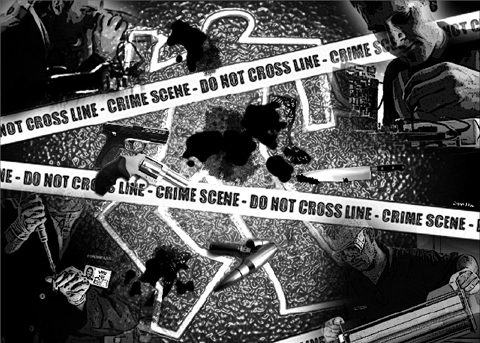As you enter a building on the northern rim of the campus at the University of Leicester in central England, the colorful signboard that catches your eye suggests science at the cutting edge. Whether or not the Space Research Center deserves this tag, cutting-edge would be absolutely the right description for the work being carried out by one of the building’s other inhabitants.
Sarah Hainsworth is an engineer who, for the past few years, has been investigating the sharpness of knives — and not just knives, but screwdrivers, scissors and even ballpoint pens. Any implement, in fact, that has featured as a murder weapon.
“If you give somebody a knife and ask them if it’s sharp, how do you measure that? How do you quantify sharpness?” Hainsworth said. “I suppose that’s what we’ve been trying to do.”

The cutlery industry has measured the effectiveness of the slicing edges of blades designed for chopping up vegetables or carving meat, and how best to maintain that sharpness, she says.
“But what nobody has really done is to investigate the sharpness of points,” she said.
They certainly have now. Hainsworth sometimes spends whole afternoons dropping knives from various heights on to foam or legs of pork — a close substitute for human skin — and recording the results in finest detail.
The ease with which a blade penetrates the human body has become an important consideration in court cases.
“When there’s been a stabbing, one of the common defenses is: I didn’t mean to kill; the knife was extremely sharp,” Hainsworth said.
The implication is that the accused is less guilty because they had not used extreme force.
Hainsworth began looking at knife sharpness in 1999 when she was leading an undergraduate project about materials that might improve their ability to retain a keen edge. Because of this work she was approached five years ago by a solicitor.
“A knife had been used in a murder,” she said. “It had made a wound of significant depth through the chest and into the spine. The accused had said he always kept his knives extremely sharp. I was asked whether I could verify this so they could use it as a defense.”
After testing the knife, she established that it was not sharp.
“I imagine the solicitor rejected that line of defense,” she said.
It was while working on that case that Hainsworth realized there was a gap in knowledge. The existing research had been short-term and was out of date.
“What we really needed to do was look at this with some of the modern tools that are available to engineers,” she said.
This lack of convincing research was posing a problem for the criminal justice system, she said.
“The courts in the first instance will ask the forensic pathologist for an indication of the degree of force required in a stabbing offense and the pathologist might assess the sharpness by testing the blade on their fingers. When you’re trying to communicate to a jury how sharp something is, I don’t think that is a particularly convincing assessment. And it’s open to criticism from the barrister on the opposing side that the method is unscientific,” she said.
Is Hainsworth’s work likely to help more people mount successful defenses against the most serious charges of violence involving knives? She cites two cases in response.
“In one, the weapon was relatively blunt and the prosecution barrister argued that because it was blunt, considerable force was used, and that influenced the sentence. I had another case where I found the weapon to be sharp, and the barrister argued that the accused had knowingly kept the knife very sharp and had taken it to use as a weapon in that knowledge,” she said.
Since beginning her research, Hainsworth said she had been asked to look at the weapons used in around a dozen cases. It has brought home to her the extent to which knives are the weapon of choice.
“Murder by knife has been the most preferred form of murder in the last few years,” she said.
A key conclusion of a research project begun in 2004 is that the tip of a knife is crucial in assessing how much force is needed to puncture the human frame. Hainsworth and colleagues have gone much further. They have established a method of measuring the sharpness of a knifepoint so that it can be positioned on a scale of sharpness and compared with other knives.
Using high-speed video film, they have gained a better understanding of the “mechanism” by which blades penetrate skin. This shows that there are a number of stages. At first contact, the skin deflects around the knife tip. At a critical stress level the knife penetrates the skin. After penetration the sharpness of both tip and blade are important in determining how much further the knife goes in.
Stress is an engineering term expressed as force, measured in Newtons divided by area, Hainsworth said. The force required to stab a person with a sharp knife is less than you might expect, she said.
“Often, once the point has gone through the skin, the force required to go further is even less,” she said.
So, is there ever credibility in the sort of excuse that runs: “I was just trying to scare him and the next moment he was lying dead?”
“In some cases, yes,” she said.
Other factors come into play in a stabbing, for instance the angle of strike and the width of blade. In further research, Hainsworth will replicate knife attacks using an accelerometer, a device that records the rapid changes in force used.
In her experience, the kitchen knife is the weapon most commonly used in murders. In recent years, more and more of these have been made with sharper tips — not necessary for the slicing and peeling most are designed for. Hainsworth suspects this is because people buying knives are often seen to check out the tip on their thumb rather then the long edge, and manufacturers have noticed this tendency.

There has been much catastrophizing in Taiwan recently about America becoming more unreliable as a bulwark against Chinese pressure. Some of this has been sparked by debates in Washington about whether the United States should defend Taiwan in event of conflict. There also were understandable anxieties about whether President Trump would sacrifice Taiwan’s interests for a trade deal when he sat down with President Xi (習近平) in late October. On top of that, Taiwan’s opposition political leaders have sought to score political points by attacking the Lai (賴清德) administration for mishandling relations with the United States. Part of this budding anxiety
The diplomatic dispute between China and Japan over Japanese Prime Minister Sanae Takaichi’s comments in the Japanese Diet continues to escalate. In a letter to UN Secretary-General Antonio Guterres, China’s UN Ambassador Fu Cong (傅聰) wrote that, “if Japan dares to attempt an armed intervention in the cross-Strait situation, it would be an act of aggression.” There was no indication that Fu was aware of the irony implicit in the complaint. Until this point, Beijing had limited its remonstrations to diplomatic summonses and weaponization of economic levers, such as banning Japanese seafood imports, discouraging Chinese from traveling to Japan or issuing
Tokyo-Beijing relations have been rapidly deteriorating over the past two weeks as China tries to punish Japan over Japanese Prime Minister Sanae Takaichi’s remarks about Taiwan earlier this month, and the off-ramp to this conflict is yet to be seen. Takaichi saying that a “Taiwan contingency” could cause a “situation threatening Japan’s survival” — which would allow Japan to act in self-defense — has drawn Beijing’s ire and sparked retaliatory measures. Her remark did not gain public attention until Chinese Consul General in Osaka Xue Jian (薛劍) made an apparent threat to behead her. The two sides lodged protests against each
On Nov. 8, newly elected Chinese Nationalist Party (KMT) Chairwoman Cheng Li-wun (鄭麗文) and Vice Chairman Chi Lin-len (季麟連) attended a memorial for White Terror era victims, during which convicted Chinese Communist Party (CCP) spies such as Wu Shi (吳石) were also honored. Cheng’s participation in the ceremony, which she said was part of her efforts to promote cross-strait reconciliation, has trapped herself and her party into the KMT’s dark past, and risks putting the party back on its old disastrous road. Wu, a lieutenant general who was the Ministry of National Defense’s deputy chief of the general staff, was recruited